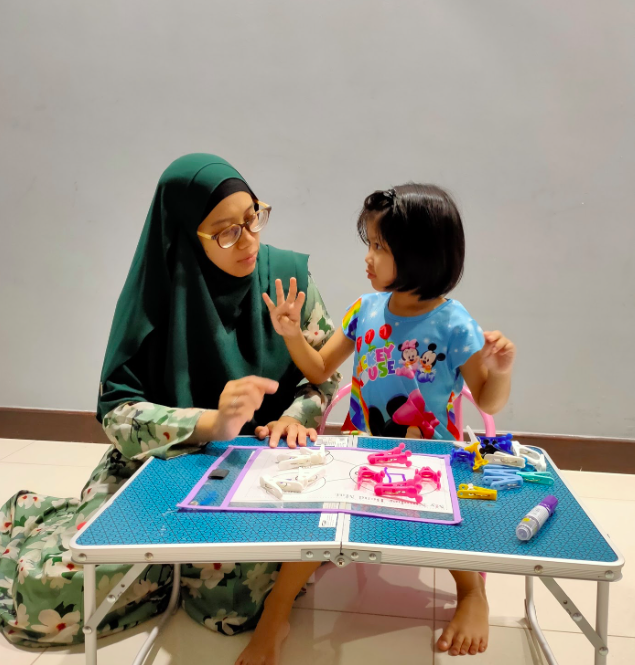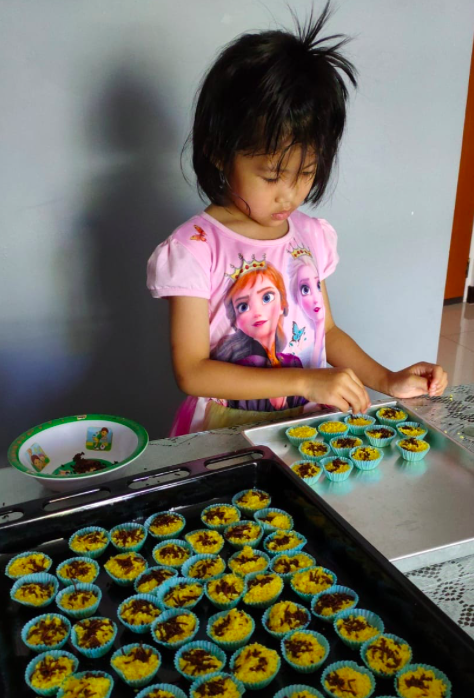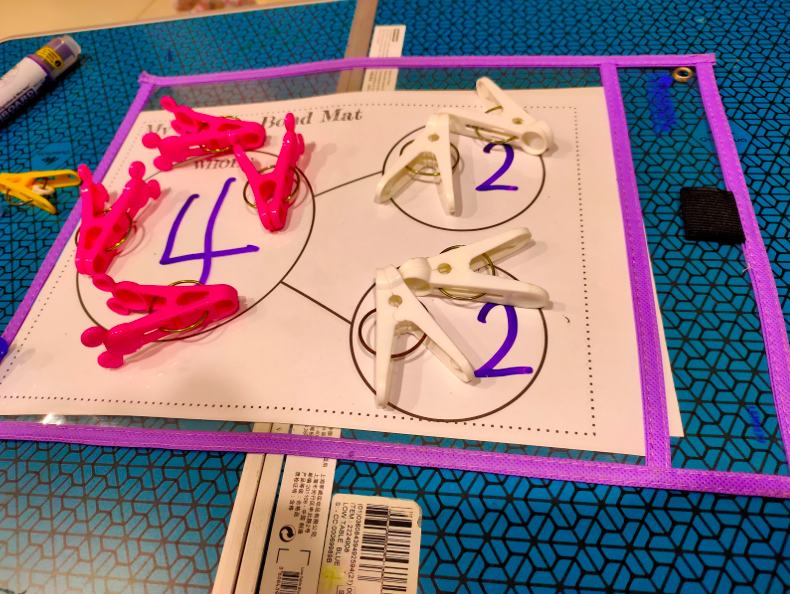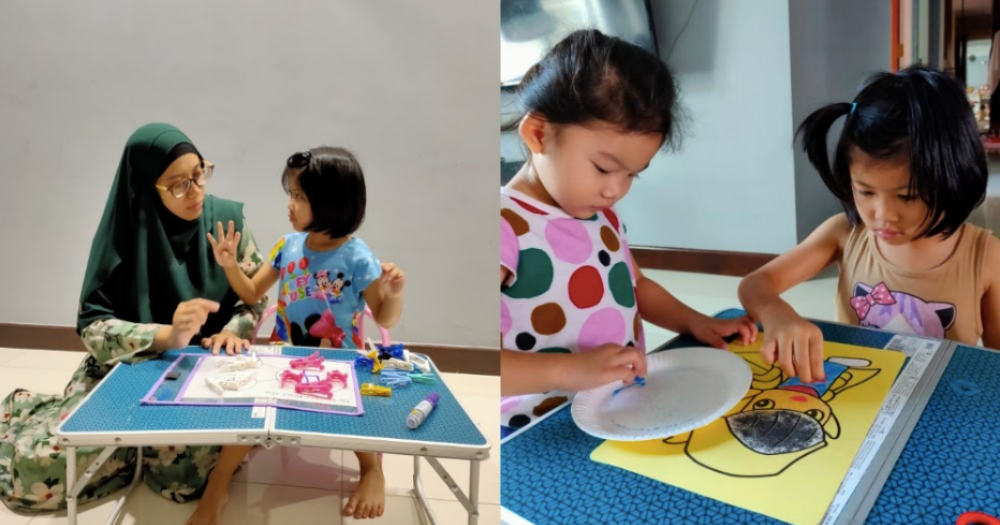Children.
So endearing to have around, but when you’re living with them 24/7 in an enclosed space, these miniature human beings miiiiight (sometimes, at the very least) get on your nerves, as many parents are likely to experience during the ongoing Circuit Breaker.
So you can imagine how juggling young children, as well as planning and executing home-based learning lessons for the children she teaches, might be for senior preschool teacher Liyana Kamsani.
The 35-year-old, who works at E-Bridge Preschool, tells us her first week working from home was “quite chaotic”, to say the least.
“My children thought that when mommy's at home, it means something is fun, mommy doesn’t need to go to work. But I tried to explain to them that mommy has work to do. So, then they would ask why? What work do you have to do?”
From our conversation with her, we picked up some tips you can consider if you haven’t already done any of these with your children at home —
1. Explain to your kids why they cannot go out
Many of Liyana’s students (and her own two daughters) tell her they miss going out to the playground or meeting their friends.
And so, she says, it is important to sit your kids down and explain that we are currently in a Circuit Breaker because of the coronavirus pandemic, as well as the importance of being socially responsible.
Children do have the capacity to understand these things, Liyana says. And she should know — she’s been working with kids for the past 15 years now.
“Some of the parents provide them with news like how many cases there are today, so the children understand.”
Liyana tried explaining to her daughters, aged three and five, for example, why they have to wear masks when they’re out. Her younger girl readily acceded to the request even though she hates wearing one.
2. Schedule time for work and family
Another thing you could do as a parent is to set a timetable for your kids, detailing time slots of homework, play, and other activities.
Establishing a daily routine for the whole family helps to maintain some semblance to normal school life.
Liyana says it took a bit of time — one week, to be exact — for her two daughters to understand that when mommy locks her door from 9am to 11am, she’s working and cannot be disturbed.
“Everything is scheduled. I try to do my work in the mornings so that I can concentrate on my children in the afternoon. If I have afternoon meetings then I spend time with them in the morning.”
 Liyana has a routine to juggle work and time with her children. Image courtesy of Liyana Kasmani.
Liyana has a routine to juggle work and time with her children. Image courtesy of Liyana Kasmani.
Good time management is crucial especially for her, considering that she has her students to attend to apart from her own children.
As a senior teacher, Liyana plans and disseminates home-based lesson plans, also sending e-greetings to her students and organising storytelling sessions over Zoom — things she has already been doing with them before Circuit Breaker kicked in.
Liyana also makes use of these Zoom meetings to talk to parents and find out how they are coping with their kids. For the children, these meetings are also a way for them to catch up with their friends.
“The children miss their own friends, it's not the teachers, you know. They are so happy to see their friends!”
And so these Zoom meetings, which can sometimes see up to 21 excitable kids in attendance, can get pretty rowdy. That’s where the mute button comes in handy, she says, laughing.
 Liyana’s e-greeting to her K2 students. She sends these greetings once a week. Image courtesy of Liyana Kasmani.
Liyana’s e-greeting to her K2 students. She sends these greetings once a week. Image courtesy of Liyana Kasmani.
3. Try thinking out of the box to make learning interactive and fun
Another thing you can try, although Liyana does recognise this to be a tall order, is to see how you can make your kids’ home-based learning more engaging and enjoyable. After all, there’s only so much a worksheet can do to stimulate a child’s imagination and keep him or her interested and focused.
Liyana says that one of the most common things she hears from her students in their Zoom meetings is that they miss the outdoors.
What can you do, then? Liyana advises that if you can’t go outdoors, you could try bringing the outdoors in. Once in a while, when energy and time permits, you could try creating an obstacle course using furniture in your house, or play bowling using bottles, for example.
After the Circuit Breaker was extended, Liyana says she and her team decided to incorporate more activities — like dancing and cooking — into their students’ home-based learning curricula.
 Liyana engages her daughter in activities like baking. Image courtesy of Liyana Kasmani.
Liyana engages her daughter in activities like baking. Image courtesy of Liyana Kasmani.
These include a video on making banana smoothies and building a playground at home using recycled materials — such creative approaches help children grasp concepts better than filling in a worksheet.
“In Term 1 they learn about simple machines. So, in the playground, there were a lot of simple machines that they could find. We also encouraged them to make a playground out of recycled materials — from a tissue box to toilet rolls.”
When her daughter was assigned a worksheet about number bonds, Liyana incorporated it with a fun activity: counting with clothes pegs. This helped her daughter grasp the concept of number bonds better before she attempted the worksheet.
 Liyana finds ways to engage her child beyond the usual worksheets. Image courtesy of Liyana Kasmani.
Liyana finds ways to engage her child beyond the usual worksheets. Image courtesy of Liyana Kasmani.
“Some parents might say, ‘Mommy needs to do the laundry, please don't disturb me’,” she says, but actually, these household chores can also become simple ways to keep your children engaged.
From sorting laundry to loading the washing machine, vacuuming the house and pegging clothes to the bamboo pole, children can also improve their fine motor skills just by doing these chores with their parents, Liyana says.
4. Don’t be afraid to consult your children’s preschool teachers for help, advice & ideas
Of course, she acknowledges that it means parents would have to spend even more time and effort out of an already busy work-from-home day to focus on their kids.
Liyana herself spends about two hours every day looking through her daughters’ lesson plans and researching ways to supplement them with fun activities.
She says this is something that she gladly does because “every parent wants the best for their children”.
“At the end of the day, the key to the child's success is the positive involvement and the time spent with your own children.”
More importantly, though, know that if you are overwhelmed and struggling to engage your children at home, preschool teachers like Liyana are on hand and happy to provide advice.
Top images courtesy of Liyana Kamsani.
Thanks to this sponsored piece by the Early Childhood Development Agency, this writer has a newfound appreciation for parents stuck at home with their children during the Circuit Breaker.
If you like what you read, follow us on Facebook, Instagram, Twitter and Telegram to get the latest updates.
